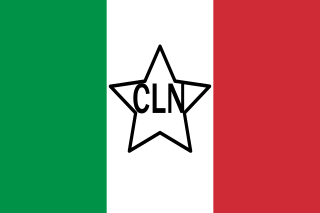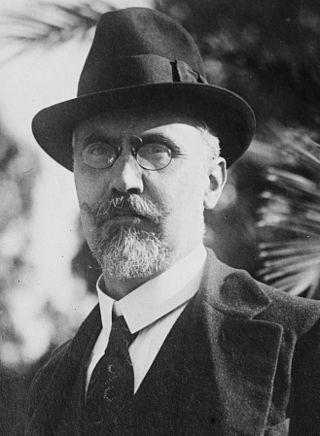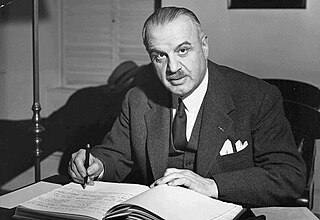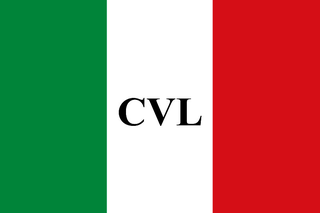
The Italian Resistance consisted of all the Italian resistance groups who fought the occupying forces of Nazi Germany and the fascist collaborationists of the Italian Social Republic during the Second World War in Italy from 1943 to 1945. As a diverse anti-fascist and anti-nazist movement and organisation, the Resistenza opposed Nazi Germany and its Fascist puppet state regime, the Italian Social Republic, which the Germans created following the Nazi German invasion and military occupation of Italy by the Wehrmacht and the Waffen-SS from 8 September 1943 until 25 April 1945.

Ivanoe Bonomi was an Italian politician and journalist who served as Prime Minister of Italy from 1921 to 1922 and again from 1944 to 1945.

The Auxiliary Corps of the Black Shirts' Action Squads, most widely known as the Black Brigades, was one of the Fascist paramilitary groups, organized and run by the Republican Fascist Party operating in the Italian Social Republic, during the final years of World War II, and after the signing of the Italian Armistice in 1943. They were officially led by Alessandro Pavolini, former Minister of Culture of the fascist era during the last years of Fascist Italy.

Giustizia e Libertà was an Italian anti-fascist resistance movement, active from 1929 to 1945. The movement was cofounded by Carlo Rosselli, Ferruccio Parri, who later became Prime Minister of Italy, Emilio Lussu, Sandro Pertini, who became President of Italy, and other Italian anti-fascist refugees.

The Italian Civil War was a civil war in the Kingdom of Italy fought during the Italian campaign of World War II between Italian fascists and Italian partisans and, to a lesser extent, the Italian Co-belligerent Army.

Alfredo Pizzoni was an Italian banker and politician who was president of the Comitato di Liberazione Nazionale Alta Italia during the late stages of World War II.

The National Liberation Committee was a political umbrella organization and the main representative of the Italian resistance movement fighting against the occupying forces of Nazi Germany and the fascist collaborationist forces of the Italian Social Republic during the German occupation of Italy in the aftermath of the armistice of Cassibile, while simultaneously fighting against Italian fascists during the Italian Civil War. It coordinated and directed the Italian resistance and was subdivided into the Central Committee for National Liberation (CCLN), which was based in Rome, and the later National Liberation Committee for Northern Italy (CLNAI), which was based in Milan. The CNL was a multi-party entity, whose members were united by their anti-fascism.
William Oliver Churchill, (1914–1997) was a Special Operations Executive (SOE) officer during the Second World War.

This is a list of words, terms, concepts, and slogans in the Italian language and Latin language which were specifically used in Fascist Italian monarchy and Italian Social Republic.
The Committee of National Liberation for Northern Italy was set up in February 1944 by partisans behind German lines in the Italian Social Republic, a German puppet state in Northern Italy. It enjoyed the loyalty of most anti-fascist groups in the region.

Liberation Day, also known as the Anniversary of Italy's Liberation, Anniversary of the Resistance, or simply 25 April, is a national holiday in Italy that commemorates the victory of the Italian resistance movement against Nazi Germany and the Italian Social Republic, puppet state of the Nazis and rump state of the fascists, culmination of the liberation of Italy from German occupation and of the Italian civil war in the latter phase of World War II. That is distinct from Republic Day, which takes place on 2 June and commemorates the 1946 Italian institutional referendum.

Roberto Lucifero d'Aprigliano was a lawyer who became a partisan. As the war ended he turned to politics and journalism.
The Italian partisan brigades were armed formations involved in the Italian resistance during the World War II.

The Brigate Garibaldi or Garibaldi Brigades were partisan units aligned with the Italian Communist Party active in the armed resistance against both German and Italian fascist forces during World War II.

The Tuscan Committee of National Liberation was an underground Italian resistance organisation during World War II based in Tuscany, Central Italy. An offshoot of the National Liberation Committee (CLN), it was charged with organising resistance and partisan activities throughout Tuscany. It was opposed to the forces of Nazi Germany as well as Nazi Germany's puppet state local regime, the Italian Social Republic, in Tuscany following the German invasion and military occupation of Italy between September 1943 and April 1945. The CTLN became an umbrella organisation for the five main anti-fascist partisan groups operating within Tuscany.

The Corpo Volontari della Libertà was the unified command structure of the Italian Resistance during the Second World War, recognized both by the Allies and the "southern" Italian governments.
Alessandro Sinigaglia, battle name Vittorio was an Italian partisan during World War II.

The Commemorative Medal of the War of Liberation is a decoration awarded by the Italian Republic to personnel who participated in military and partisan operations of the Italian co-belligerent forces or the Italian resistance movement against the Axis powers during the Italian campaign of World War II and the coincident Italian Civil War. It originated in 1945 as the Kingdom of Italy's Badge of the Ongoing War of Liberation Against the Germans, which the Italian Republic replaced with the Liberation War Badge in 1948. In turn, the Commemorative Medal of the War of Liberation replaced the Liberation War Badge in 1959.
The Badge of Honor for the "Volunteers of Freedom" Patriots is an award established by the Kingdom of Italy to recognize those who participated in the armed struggle of the Italian resistance movement or Italian Co-belligerent Forces against Axis forces in Italy during World War II or who refused to collaborate with Axis forces after being taken prisoner by Nazi Germany.

The Ossola Republic was a partisan republic that was established in northern Italy on September 10, 1944 and recaptured by the fascists on October 23, 1944. Unlike other partisan republics, the Ossola Republic was able, in little more than a month of existence, to cope not only with the contingencies imposed by the state of war, but also to give itself an articulate organization, with the establishment of the Provisional Government Council of Domodossola and the liberated zone (G.P.G.). During the albeit brief Forty Days of Freedom, illustrious figures such as Umberto Terracini, Piero Malvestiti and Gianfranco Contini collaborated on the drafting of democratically oriented reforms, which would later inspire the drafting of the Italian Constitution.














